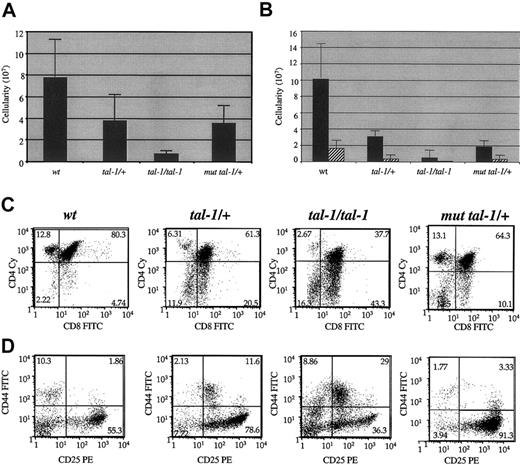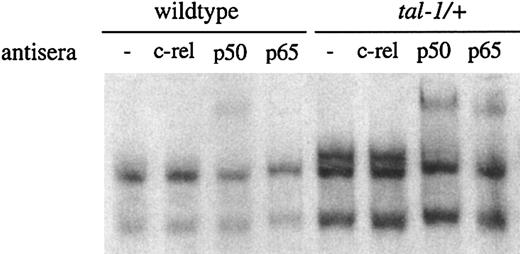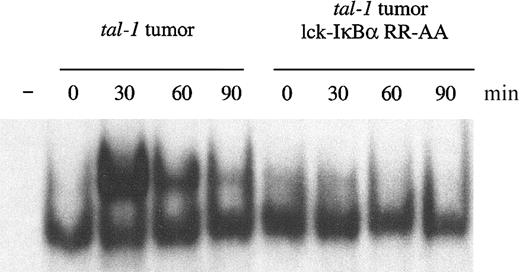Abstract
TAL-1/SCL activation is a common genetic event in pediatric T-cell acute lymphoblastic leukemia (T-ALL). Expression of tal-1/scl or a DNA binding mutant of tal-1/scl induces arrest of thymocyte development, resulting in decreases in double-positive and single-positive CD4 thymocytes. Moreover, nuclear p65/p50 heterodimers are detected in premalignant tal-1/scl and mut tal-1/scl thymocytes, suggesting that E2A depletion may induce developmental arrest and stimulate NF-κB activation. Increased NF-κB activity is also observed in tal-1/scl tumors and bcl-2 is overexpressed. To examine the contribution of NF-κB to tal-1/scl tumor growth in vivo, we expressed a mutant form of IκBα in tal-1/scl tumor cells. Although expression of mutant IκBα inhibited the tumor necrosis factor alpha (TNF-α)-induced NF-κB response, it had no effect on tumor growth in mice. These data suggest that NF-κB activation is an early event in tal-1/scl-induced leukemogenesis, associated with arrest of thymocyte development, and does not appear to contribute to tal-1/scl-induced tumor growth. (Blood. 2003;102:2593-2596)
Introduction
The transcription factor NF-κB is constitutively active in breast, colon, and gastric cancers and in lymphoid and myeloid malignancies. Initially discovered as a viral oncogene in an avian retrovirus, NF-κB genes have been increasingly implicated in the development of malignancy.1
The NF-κB gene family consists of rel A (p65), rel B, and c-rel. These NF-κB proteins form homo- or heterodimers and are bound in the cytoplasm by inhibitor of κB proteins (IκB). Infection or exposure to proinflammatory cytokines activates the IκB kinase (IKK) which consists of 2 catalytic subunits, IKK-α and IKK-β, and a regulatory subunit, IKK-γ or Nemo. The activated IKK complex phosphorylates IκB at 2 conserved serines within the IκB N-terminus. Phosphorylation then targets IκB for ubiquitination and subsequent degradation. The NF-κB dimers are then free to translocate to the nucleus where they transactivate the expression of genes involved in inflammation, proliferation, and cell survival.2
A recent survey of adult patients with T-cell acute lymphoblastic leukemia (T-ALL) revealed that 39 of 42 patients exhibited NF-κB activation.3 Yet the cause or effect(s) of elevated NF-κB activity in the human T-ALL leukemic cells is not known. The basic helix-loop-helix TAL-1/SCL gene is activated in as many as 60% of pediatric patients with T-ALL by a variety of genetic mechanisms.4 In our mouse models of tal-1/scl-induced leukemia/lymphoma,5,6 we observe dramatic decreases in overall thymocyte cellularity and an arrest of thymocyte development. Similar to what has been reported in human T-ALL,3,7 mouse tal-1/scl premalignant thymocytes and tumors exhibit nuclear p65/p50 and increased IKK activity. Yet, inhibition of NF-κB in mouse tal-1/scl tumors had no effect on tumor growth/survival in vivo, suggesting that NF-κB activation may contribute to the premalignant phase of tal-1/scl-induced disease.
Materials and methods
Flow cytometry
Thymocytes from 4-week-old, age-matched, tal-1/scl, mut tal-1/scl transgenic and control littermate mice were stained with cytochrome-c-conjugated antimouse L3T4 (CD4) and phycoerythrin (PE)-conjugated Ly-2 (CD8) (Pharmingen, San Diego, CA). For double-negative analysis, cells were stained with antibodies for the lineage markers and the lineage-negative cells were stained with CD25-PE and CD44-fluorescein isothiocyanate (FITC) and analyzed by flow cytometry.
Electrophoretic mobility shift assay (EMSA) and Western blotting
Nuclear extracts were prepared from wild-type, premalignant tal-1/scl or mut tal-1/scl thymocytes, and tal-1/scl or mut tal-1/scl tumors, and were incubated with a 32P-labeled double-stranded oligonucleotide probe containing the NF-κB consensus sequence (Promega, Madison, WI). Antibodies against p65, p50, and c-rel used for supershifting were obtained from Nancy Rice of the National Cancer Institute (Bethesda, MD).
To analyze bcl-2 expression, wild-type thymocytes and tal-1/scl tumor cells were lysed and immunoblotted with antibodies against bcl-2 and bcl-XL (Pharmingen). The blot was then stripped and reprobed with an antibody against β-actin (Sigma, St Louis, MO).
In vitro kinase assay
Tal-1/scl tumors or thymocytes from tal-1/scl transgenic or control littermates were lysed and immunoprecipitated with anti-IKK-γ antibody (Santa Cruz Biotechnology, Santa Cruz, CA) and an in vitro kinase assay performed as described in Mudgett et al.8
Injection of tumor cells into syngeneic mice
Tal-1/scl tumor cells or tal-1/scl tumor cells expressing mutant IκBα were injected intraperitoneally into 2 or 3 syngeneic FVB/N mice. All animals developed palpable tumors within 6 weeks after the injection. All tissue samples were histologically evaluated at the Transgenic Core Pathology Laboratory at the University of California at Davis.
Results
Tal-1/scl expression results in decreases in CD4 and CD8 double-positive thymocytes and in CD4 single-positive thymocytes
Thymocyte expression of the tal-1/scl oncogene results in a 2- to 8-fold decrease in overall thymocyte cellularity (Figure 1A). Moreover, perturbations in the relative percentage of CD4+ and CD8+ thymocytes as well as CD4 single-positive thymocytes is observed (Figure 1B). In mice homozygous for the tal-1 transgene (tal-1/tal-1), there is a 60-fold decrease in the absolute numbers of double-positive (DP) thymocytes and a 133-fold decrease in the absolute numbers of CD4 single-positive thymocytes. Interestingly, mice expressing a DNA binding mutant of tal-1 (mut tal-1) also exhibit thymocyte developmental abnormalities (Figure 1), suggesting that induction of novel tal-1/scl target genes are not required to arrest thymocyte development.
Thymocyte developmental arrest in tal-1/scl and muttal-1 transgenic mice. (A) Total thymocyte cell numbers from 4-week-old wild-type and tal-1/+, tal-1/tal-1, and mut tal-1/+ transgenic mice. (B) Tal-1 transgenic mice have reduced numbers of DP and CD4+cells. The absolute numbers of DP (▪) and CD4+ (▨) cells in wild-type, tal-1/+, tal-1/tal-1, and mut tal-1/+ 4-week-old mice are plotted. Error bars indicate variability from animal to animal. (C) Tal-1 expression perturbs thymocyte development. Thymocytes from 4-week-old wild-type, tal-1/+, tal-1/tal-1, and mut tal-1/+ transgenic mice were stained with CD4-Cy and CD8-FITC and analyzed by flow cytometry. (D) Tal-1/scl expression in the thymus blocks the progression of cells through the stages of double-negative development. Cells were stained with antibodies for the lineage markers IgM, Ter119, Gr1, Mac1, PanNK, CD3, CD4, and CD8 as well as CD25-PE and CD44-FITC. The staining of lineage-negative cells with CD25-PE and CD44-FITC is shown. Numbers in quadrants represent percent of cells stained with antibodies.
Thymocyte developmental arrest in tal-1/scl and muttal-1 transgenic mice. (A) Total thymocyte cell numbers from 4-week-old wild-type and tal-1/+, tal-1/tal-1, and mut tal-1/+ transgenic mice. (B) Tal-1 transgenic mice have reduced numbers of DP and CD4+cells. The absolute numbers of DP (▪) and CD4+ (▨) cells in wild-type, tal-1/+, tal-1/tal-1, and mut tal-1/+ 4-week-old mice are plotted. Error bars indicate variability from animal to animal. (C) Tal-1 expression perturbs thymocyte development. Thymocytes from 4-week-old wild-type, tal-1/+, tal-1/tal-1, and mut tal-1/+ transgenic mice were stained with CD4-Cy and CD8-FITC and analyzed by flow cytometry. (D) Tal-1/scl expression in the thymus blocks the progression of cells through the stages of double-negative development. Cells were stained with antibodies for the lineage markers IgM, Ter119, Gr1, Mac1, PanNK, CD3, CD4, and CD8 as well as CD25-PE and CD44-FITC. The staining of lineage-negative cells with CD25-PE and CD44-FITC is shown. Numbers in quadrants represent percent of cells stained with antibodies.
Tal-1/scl transgenic mice and mice expressing a DNA binding mutant of tal-1 (R188G; R189G; designated mut tal-1/scl) exhibit dramatic arrest at the DN3 stage of thymocyte development, with 79% to 91% of the double-negative (DN) cells expressing CD44 and CD25. The fact that tal-1 and the DNA binding mutant of tal-1 both stimulate thymocyte arrest is consistent with the idea that tal-1 induces arrest by depleting E2A proteins.
NF-κB activation in premalignant tal-1/scl thymocytes and tumors
To determine if NF-κB is activated in thymocytes expressing the tal-1/scl oncogene, electrophoretic mobility shift assays (EMSAs) were performed on nuclear extracts prepared from premalignant tal-1/scl transgenic mice and control littermates. A complex binding to the consensus oligo was detected in the tal-1/scl and mut tal-1/scl thymocytes (not shown) but not in thymocytes from control littermates. Supershift analysis demonstrated that the complex contains p65 and p50, but not c-rel (Figure 2). Therefore, tal-1/scl expression in thymocytes results in an increase in NF-κB (p65/p50) DNA binding activity. However, tal-1/scl and the DNA binding mutant of tal-1/scl induce NF-κB activation, suggesting that p65 is not a direct target gene of the tal-1/E47 heterodimer.
NF-κB activation in premalignant tal-1/scl transgenic thymocytes. Nuclear extracts were prepared from thymocytes from age-matched wild-type and tal-1 transgenic mice. The extracts were incubated with an oligonucleotide probe containing the NF-κB consensus sequence. The binding reactions were fractionated on a 5% polyacrylamide gel and the DNA-protein complexes were detected by autoradiography. The presence of NF-κB subunits was determined by supershifting with antibodies against p50, p65, and c-rel.
NF-κB activation in premalignant tal-1/scl transgenic thymocytes. Nuclear extracts were prepared from thymocytes from age-matched wild-type and tal-1 transgenic mice. The extracts were incubated with an oligonucleotide probe containing the NF-κB consensus sequence. The binding reactions were fractionated on a 5% polyacrylamide gel and the DNA-protein complexes were detected by autoradiography. The presence of NF-κB subunits was determined by supershifting with antibodies against p50, p65, and c-rel.
We then examined 3 mouse tal-1/scl and 2 mut tal-1/scl tumors for evidence of NF-κB activation. Nuclear extracts were prepared from the primary tal-1/scl and mut tal-1/scl tumors and EMSAs performed. We detected the p65/p50 heterodimer in the nucleus of all 5 tal-1/scl and mut tal-1/scl tumors examined (Figure 3A-B), suggesting that NF-κB activation is associated with tal-1/scl-induced leukemogenesis in the mouse.
Constitutive NF-κB activation and bcl-2 expression in tal-1 and muttal-1 tumors. (A) Nuclear extracts were prepared from wild-type thymocytes, tal-1 tumors, and mut tal-1 tumors and incubated with a radiolabeled NF-κB consensus oligonucleotide probe. As a positive control for NF-κB activation, nuclear extracts were also prepared from murine embryonic fibroblasts (mef) left untreated or treated with the cytokine TNF-α. The binding reactions were fractionated on a 5% polyacrylamide gel and the DNA-protein complexes were detected by autoradiography. (B)NF-κB complex in tal-1/scl tumors contains p65/p50. Binding reactions were incubated with antibodies against p50, p65, and c-rel prior to separation on a nondenaturing gel. (C) Total cell lysates (50 μg) were fractionated on a 12% sodium dodecyl sulfate-polyacrylamide gel electrophoresis (SDS-PAGE) gel and immunoblotted with an anti-bcl-2 antibody. Lysates were probed with an anti-β-actin antibody to control for the amount of total protein.
Constitutive NF-κB activation and bcl-2 expression in tal-1 and muttal-1 tumors. (A) Nuclear extracts were prepared from wild-type thymocytes, tal-1 tumors, and mut tal-1 tumors and incubated with a radiolabeled NF-κB consensus oligonucleotide probe. As a positive control for NF-κB activation, nuclear extracts were also prepared from murine embryonic fibroblasts (mef) left untreated or treated with the cytokine TNF-α. The binding reactions were fractionated on a 5% polyacrylamide gel and the DNA-protein complexes were detected by autoradiography. (B)NF-κB complex in tal-1/scl tumors contains p65/p50. Binding reactions were incubated with antibodies against p50, p65, and c-rel prior to separation on a nondenaturing gel. (C) Total cell lysates (50 μg) were fractionated on a 12% sodium dodecyl sulfate-polyacrylamide gel electrophoresis (SDS-PAGE) gel and immunoblotted with an anti-bcl-2 antibody. Lysates were probed with an anti-β-actin antibody to control for the amount of total protein.
The transcription factor NF-κB controls the expression of several antiapoptotic proteins including the inhibitors of apoptosis (cIAPs), BCL-2, and BCL-XL.9-11 To determine whether constitutive NF-κB activity in tal-1/scl tumors correlates with the expression of antiapoptotic proteins, we examined bcl-2 and bcl-XL expression levels in tal-1/scl tumors. In contrast to wild-type thymocytes, tal-1/scl tumors expressed increased amounts of the bcl-2 protein (Figure 3C), whereas the bcl-XL protein was not detected in any of the tal-1/scl tumors examined (not shown).
Elevated IKK activity in premalignant tal-1/scl thymocytes and tal-1/scl tumors
To determine the mechanism of NF-κB activation, we examined IκB kinase activity in premalignant tal-1/scl thymocytes and in tal-1/scl tumors using an in vitro kinase assay and GST-IκB as a substrate. IKK activity was increased in premalignant tal-1/scl thymocytes compared with thymocytes from control littermates (Figure 4). In addition, IKK activity was increased in the 3 tal-1/scl and 2 mut tal-1/scl tumors examined. Taken together, these studies suggest that the nuclear p65 observed in the premalignant tal-1/scl thymocytes and in the tal-1/scl tumors may reflect constitutive IKK activation.
Increased IKK activation in premalignant tal-1/scl thymocytes and tumors. Thymocytes isolated from 4-week-old tal-1/scl transgenic and control littermates were lysed and immunoprecipitated with an anti-IKK-γ antibody and used in an in vitro kinase assay with GST-IκBα as the substrate. Whole-cell lysates were also prepared from tal-1/scl tumor cell lines. To insure that equivalent amounts of IKK were immunoprecipitated, the lysates were probed with an anti-IKK-α antibody.
Increased IKK activation in premalignant tal-1/scl thymocytes and tumors. Thymocytes isolated from 4-week-old tal-1/scl transgenic and control littermates were lysed and immunoprecipitated with an anti-IKK-γ antibody and used in an in vitro kinase assay with GST-IκBα as the substrate. Whole-cell lysates were also prepared from tal-1/scl tumor cell lines. To insure that equivalent amounts of IKK were immunoprecipitated, the lysates were probed with an anti-IKK-α antibody.
Inhibition of NF-κB activity does not alter tal-1/scl tumor growth in vivo
Although NF-κB complexes have been detected in human ALL samples,3 the contribution of these complexes to leukemogenesis is unclear. In order to elucidate how NF-κB activation contributes to disease progression in vivo, we introduced a mutated form of IκBα under the control of the proximal lck promoter into 3 mouse tal-1/scl tumor cell lines. This IκB mutant functions as a superinhibitor because it binds NF-κB and inhibits DNA binding as well as nuclear translocation.12 As expected, expression of the superinhibitor in the tal-1/scl tumor cells leads to a decrease in nuclear p65/p50 heterodimers. Furthermore, tumor necrosis factor alpha (TNF-α)-induced NF-κB activation is repressed in tal-1/scl tumors expressing the mutant IκB (Figure 5).
Mutant IκBα expression inhibits TNF-α-induced NF-κB activation in tal-1/scl tumors.Tal-1 tumor cells were electrophorated with lck-IκBα RR-AA-F-PEST and a plasmid encoding the neomycin resistance gene. Cells were selected for resistance to G418 and subsequently treated with TNFα for the time periods indicated. Nuclear extracts prepared from these cells were incubated with a radiolabeled NF-κB consensus oligonucleotide and fractionated on a 5% nondenaturing polyacrylamide gel.
Mutant IκBα expression inhibits TNF-α-induced NF-κB activation in tal-1/scl tumors.Tal-1 tumor cells were electrophorated with lck-IκBα RR-AA-F-PEST and a plasmid encoding the neomycin resistance gene. Cells were selected for resistance to G418 and subsequently treated with TNFα for the time periods indicated. Nuclear extracts prepared from these cells were incubated with a radiolabeled NF-κB consensus oligonucleotide and fractionated on a 5% nondenaturing polyacrylamide gel.
To test whether inhibition of NF-κB activation affects tumor growth in vivo, tal-1/scl tumors and tal-1/scl tumors expressing the NF-κB superrepressor were injected into syngeneic mice. No differences in tumor latency or in tumor size were observed (Table 1). Histopathologic examination of the injected mice did not reveal differences in tumor invasiveness or metastasis. Our failure to observe an effect of the IκB superinhibitor on tal-1/scl tumor growth in vivo did not reflect the fact that the injected tumors no longer expressed the mutant IκB superinhibitor. Thus, inhibition of NF-κB activity in tal-1/scl tumor cell lines does not appear to alter tumor growth or invasiveness in vivo.
Discussion
We find NF-κB activation to be an early event in tal-1/scl-induced disease, associated with the premalignant phase of the disease. NF-κB activation in tal-1/scl, mut tal-1/scl, and Id1 transgenic thymocytes13 suggests that reduced E2A activity may result in thymocyte arrest and NF-κB activation. Thus, NF-κB activation may function to stimulate DP thymocyte apoptosis. Consistent with this idea, inhibition of NF-κB activity in Id1 transgenic thymocytes partially rescues DP thymocytes.13 Yet, elevated NF-κB activity is maintained in tal-1/scl tumors and the tumors overexpress bcl-2, suggesting to us that NF-κB may have additional roles in tal-1/scl-induced disease. Although NF-κB inhibition in established tal-1/scl tumor cell lines had no effect on tumor growth, NF-κB inhibition during the premalignant phase may have different effects.
Prepublished online as Blood First Edition Paper, June 19, 2003; DOI 10.1182/blood-2003-01-0090.
Supported by a Sidney Kimmel Cancer Scholar Award and a Leukemia Research Foundation grant to M.K.
The publication costs of this article were defrayed in part by page charge payment. Therefore, and solely to indicate this fact, this article is hereby marked “advertisement” in accordance with 18 U.S.C. section 1734.
We thank Dr Sankar Ghosh of Yale University, New Haven, CT, for providing the plasmid encoding the mutant IκBα superrepressor.






